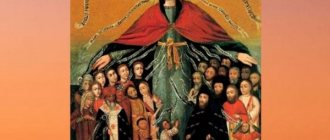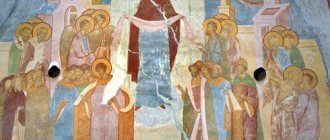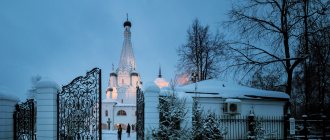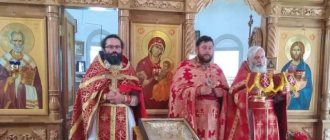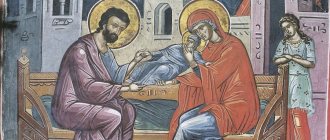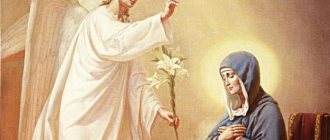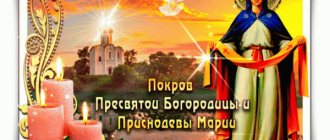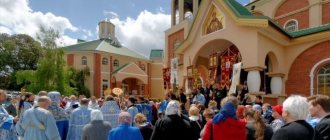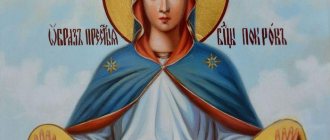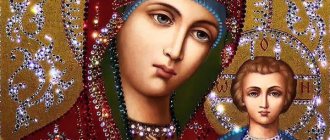"Save me, God!".
Thank you for visiting our website, before you start studying the information, please subscribe to our Orthodox community on Instagram, Lord, Save and Preserve † - https://www.instagram.com/spasi.gospodi/. The community has more than 60,000 subscribers. There are many of us like-minded people and we are growing quickly, we post prayers, sayings of saints, prayer requests, and timely post useful information about holidays and Orthodox events... Subscribe. Guardian Angel to you!
The great church celebration of the Intercession of the Most Holy Theotokos has long been celebrated by believers all over the world. He is loved and revered. It is a symbol of faith and protection. After all, it is the Most Pure One who helps get rid of many troubles and protects everyone who asks.
This day is marked in the Orthodox calendar on October 14. This is a kind of border between autumn and winter, so it is fraught with many traditions, rituals and signs that are strictly followed today. Next, you will learn what the Feast of the Intercession of the Blessed Virgin Mary means, its history, traditions and signs.
What is the Intercession of the Blessed Virgin Mary
The word “cover” refers to the masculine gender and represents the upper layer that covers something. However, in the context of a religious celebration, “veil” has a slightly different meaning.
The Feast of the Intercession of the Blessed Virgin Mary falls on October 14
The Protection of our Most Holy Lady Theotokos and Ever-Virgin Mary - after all, this is the correct name for the Orthodox holiday - is a symbol of faith and protection for everyone who asks. It is believed that the Virgin Mary helps those suffering to get rid of troubles and disappointments and gain faith in themselves and the Almighty.
The cover that the Most Holy Theotokos took off from Her head and spread over those asking for help carries strength and protection from all adversities.
Traditions and rituals of the holiday
Services are held in churches. Parishioners visit churches, pray to the Virgin Mary in the hope of receiving healing and blessing.
Among the people, Intercession Day is marked by the completion of field work and grazing of livestock. Villagers are preparing for cold weather.
At this time, the wedding season began and round dances stopped. They were replaced by gatherings (a type of leisure time for young peasants).
Girls who wanted to get married as soon as possible came to the temple on October 14 and, lighting a candle, prayed for Paraskeva Pyatnitsa, asking for help in getting married. It was believed that whoever does this first will have his dream come true first.
Women burned old things and beds.
Children standing on the threshold were doused with water through a sieve to protect against illness.
History of the celebration
Every year on October 14, Orthodox Christians celebrate the Intercession of the Blessed Virgin Mary. Despite the fact that this holiday is not included in the list of the twelfth celebrations of the church calendar, many believers and clergy consider it the most significant and important in the autumn period.
The origin of the holiday dates back to 910. At that time, the majestic and mighty Constantinople was captured by the Saracens. The raids of the barbarians were always accompanied by bloody massacres and cruel tortures. Many residents waited for the morning to say goodbye to their mortal lives and go to another world. No one hoped for a miraculous rescue.
The cover carries strength and protection from all adversities
One night, the clergy were praying in the Blachernae Church in the city of Constantinople. And a vision appeared to the holy fool Andrew of Constantinople: the Virgin Mary, illuminated by heavenly light and surrounded by angels, bowed her knees in prayer. Then She stood up, took the veil from her head and covered the worshipers with it. After this vision, the barbarians left the city - Constantinople and its inhabitants were saved.
Do's and Don'ts
For Orthodox Christians on the Feast of the Intercession, the most important action is visiting the temple, praying to the glory of the Mother of God, and turning to the Mother of God with words of help. Those who, for certain reasons, cannot come to church for services, pray at home.
Among the holiday prohibitions:
- work in the field and garden;
- wash;
- needlework;
- cleaning.
We tried to clean the house for the celebration and complete the main tasks. Working on a holiday is a bad omen, but if there were urgent matters, they did them in good faith. You cannot borrow on this date, and it is advisable to repay it before the Intercession or after.
As on any other Orthodox holiday, on Intercession you cannot swear, quarrel, or abuse alcoholic beverages. At the same time, the point is not in prohibitions, but in traditions, in the awareness that the day is solemn, special, festive. And conflicts, unnecessary insults, and abuse will only darken the bright triumph.
Orthodox Christians should have fun, set the table and invite relatives and close people to celebrate. We must not forget about the poor and the poor, therefore alms and treats for the disadvantaged are welcomed. It is advisable to feed grain to the birds, as this was considered a good omen. The girls braided their hair in the morning and unbraided it only in the evening, before going to bed.
Features of the celebration
The Protection of the Blessed Virgin Mary is a good and cheerful Orthodox holiday, which is accompanied by numerous traditions and rituals.
Folk customs
In Rus', they were of the opinion that on this day the meeting of autumn and winter takes place. Therefore, before the Intercession it was necessary to complete all the work in the house and in the yard. All available livestock was driven into a barn. It was important to provide the animals with enough food so that they could not eat it in one day. Otherwise, the year could have been hungry and cold.
Housewives baked pancakes and Pokrovsky loaf. Before sitting down to the table, you had to go around the house with a loaf of bread and read a prayer to the Most Holy Mother of God. The remaining pieces and crumbs from the sweet bread were dried and preserved until Lent.
A candle was lit in the church in honor of the Blessed Mother. A bright flame meant a rich and happy life, an even flame meant a calm and measured life. If the candle goes out, the loss of a loved one is possible.
Helpful information
On this day, housewives baked pancakes and Pokrovsky loaf
Signs and dreams
Pokrova is a day when people ask for protection from misfortune, grief and misfortune. Those praying ask the Virgin Mary for protection for themselves and their children.
In Rus' they looked at the weather: if there was a lot of snow, it meant there would be a large number of weddings. Snow represented the innocence of the bride, her veil or wedding veil. Unmarried girls hurried to church to light a candle and pray to the Blessed Virgin for the granting of a happy married life.
The children were sprinkled through a sieve. This is how they tried to protect them from illnesses and evil people. It was believed that if you burn dry branches of apple trees on this day, the house will be warm and cozy.
The weather determined the proximity of winter. If there was frost on the branches, autumn will still linger. The wind from the south signified a warm autumn, and from the east - a cold one. The wind from the west spoke of imminent snow. Seeing cranes flying away in the sky means frost.
Dreams were of particular importance on this day. If an unmarried girl saw a man in a dream, she can expect to meet her betrothed soon. Therefore, many young ladies, going to bed, asked the Lord God and the Most Pure Virgin to show them their future spouse in a dream.
Intercession of the Virgin Mary – fresco of the Ferapontov Monastery
What not to do
The Orthodox holiday of the Intercession does not have any strict restrictions. As during the celebration of other important church dates, on this day it is not recommended to do “dirty” household work: washing, cleaning the house, sweeping the floor and taking out the trash. The Church strictly prohibits swearing and sorting things out on this day. You should also not drink alcohol or eat heavy food. If the Intercession falls on Wednesday or Friday, you can eat fish dishes.
On holiday, it is better to give up sewing, embroidery, knitting and other types of needlework. However, it was after the Intercession that girls in the old days organized evening gatherings with knitting and embroidery.
Why is it forbidden to lend money or refuse matchmakers on this day? It is believed that if you lend someone money for the Intercession, you will then experience financial difficulties for several years. And the girl who refused the matchmakers will continue to be a bride for another three years.
Rituals and traditions of the holiday
For Orthodox Christians, October 14th is a special day. Intercession is celebrated as a great church holiday; the services are similar to the services of the Twelve Feasts. It is customary to pray for family happiness, for the health of children and loved ones, for well-being in the home.
The clergy perform festive liturgies, glorify the Mother of God, and preach to the parishioners. Divine services have a special status of “magnificence”, since they address and magnify the Virgin Mary. Believers must visit churches, turn to the image of the Mother of God with prayers, and ask for help and intercession.
Like many other Orthodox holidays, Intercession combined the traditions and ritual actions of Christianity and paganism. In folk culture, it was associated with the agricultural cycle, with the completion of basic agricultural work. For the peasant, this is a special, borderline time, so there were many rituals and ceremonies associated with the end of autumn and the welcoming of winter.
The milestone day marked the transition to a special period - winter. The main work was transferred to the huts, so they tried to complete the insulation of the houses and prepare them for the cold and harsh season. They caulked the huts in time for the Intercession, otherwise it would be cold in the winter. Men and boys were freed from hard work in the fields, so it was customary to leave Pokrov for winter earnings. Trades and fairs continued, people brought the harvested crops for sale, and completed the preparation of supplies for the winter. The harvesting of vegetables from the gardens was completed, and the sheaves were stacked in the barns.
Housewives lit the stoves, using apple tree branches for ignition on this day. It was believed that such a ritual would contribute to a good harvest in the gardens for the next year. They put out the dough and baked pancakes and a large loaf of bread from early morning. Among the pagans in Rus', pancakes were considered a funeral dish, so when treating them to baked goods, they paid tribute to deceased relatives. The loaf was supposed to be eaten at the festive table, inviting relatives, neighbors, and friends. The remains were dried in the oven and stored until the beginning of Lent.
Veil is the boundary of transactions and work for hire. There was a tradition of hiring workers for the season from this holiday, paying for the work done (with shepherds, assistants). Those who went to summer work returned home and, conversely, artisans left Intercession to retire.
Girls of marriageable age were looking forward to the holiday with special excitement. They told fortunes, wove special canvases (“shrouds”), prayed to the Mother of God and asked to send a smart, healthy and handsome groom. It was important to spend the day in joy, because according to legend, if you spend the Intercession in a cheerful mood, then you will find a good groom. In many villages in Russia, girls gathered a large communal table and prepared treats: pancakes, porridge, pastries. Guys always came to the gatherings, brought treats, and flirted with the girls they liked. It was customary on this day to give gifts to girls, so young people tried not to skimp and please the girls with rings or earrings.
They “got married” in the huts, since it was getting cool from the Intercession and the round dances stopped. The time for gatherings and festive evenings had begun. On weekdays, young girls usually gathered to while away long evenings doing handicrafts; on weekends, they organized festivities with dancing and games.
Married young women turned to the Mother of God with prayers for help, for protection from the evil eye, for the health of children and relatives. They burned straw feather beds in the barns, replaced the bed with new straw or hay, believing that this was how they got rid of the evil eye. Children were doused with water through a sieve, believing that such a ritual would protect them from colds in winter. Elderly women burned old bast shoes, believing that they would still look good next spring and summer in a new pair.
Temples and icons of the Intercession of the Blessed Virgin Mary in Rus'
The significance and importance of the feast of the Blessed Virgin Mary is evidenced by the huge number of churches erected and painted images. Thus, the first churches in honor of the Intercession of the Mother of God appeared in Rus' in the 12th century. For example, in 1165, Andrei Bogolyubsky built a church in honor of the triumph of the Blessed Virgin. A picturesque hill among a water meadow near the Klyazma and Nerl rivers was chosen as the location for the holy temple.
Other equally famous churches of the Intercession of the Blessed Virgin Mary include:
- wooden Intercession Cathedral on the Moat (now St. Basil's Cathedral);
- temple on the territory of the Intercession Monastery in Suzdal;
- Zverin Monastery located in Veliky Novgorod;
- the Nikolsky Antoniev Church, built in the 1590s on the territory of the Krasnokholmsky Monastery (Tver region, Sloboda village);
- the temple of the same name in the village of Bolotovo, Pskov region;
- the Church of the Blessed Virgin Mary erected on Pokrovskaya Mountain in Bryansk;
- Church in honor of Our Lady in Rubtsov (Moscow);
- a temple in the name of the Mother of God in the city of Miass, Chelyabinsk region;
- Intercession Cathedral near Paveletskaya metro station (Moscow);
- stauropegial convent in Moscow.
Church of the Intercession on the Nerl
Church of the Virgin Mary of the Intercession Monastery in Suzdal
Zverin Intercession Monastery in Veliky Novgorod
Temple in Moscow, in Rubtsov
Two main iconographic images of the Intercession are known - these are the Suzdal and Novgorod Mother of God. On holy faces the Most Pure Virgin is depicted against the background of God's temple or inside it. She extends the veil over the worshipers with their heads bowed. The images that are located in the Ferapontov Monastery, in the Suzdal Conception Church, the Novgorod Church, and the Goritsky Resurrection Monastery are endowed with special power.
On October 14, the day of the celebration of the Intercession of the Most Holy Theotokos, it is customary to have spiritual conversations. Filled with good traditions and rituals, the celebration instills peace and faith in the Almighty powers in the hearts of believers.
If you find an error, please select a piece of text and press Ctrl+Enter.
Signs
According to signs, the more pancakes are baked on the holiday, the warmer the house will be in winter.
The Protection of the Blessed Virgin Mary is a maiden holiday, therefore, many signs were associated with matchmaking and marriage. Starting from October 14, according to custom, matchmakers were sent to the brides and agreed on upcoming weddings.
The girls asked the Most Holy Theotokos to give her a groom, so in the morning they ran to the church to light a candle in front of the icon. According to signs, the girl who lights the candle first will get married first.
Spending the Feast of the Intercession of the Blessed Virgin Mary cheerfully was considered a good omen - it means the long-awaited groom will appear soon. To lure the groom, according to custom, they baked bread and placed it on the windowsill.
Prosperity and well-being, according to signs, were promised to the newlyweds by the snow that fell on Pokrov, and the more snow, the more weddings. In the old days there was a sign that if a guy and a girl met on Pokrov, they would become the bride and groom.
According to signs, the winter will be the same as the wind blows on Pokrov - the northern one indicated a cold one, and the southern one indicated a warm one.
If the first snow falls before the Intercession, this is a sign indicating that winter will still have a long wait.
Miracles associated with the Intercession of the Virgin Mary
During the Crimean War in 1855, Odessa was besieged by an enemy fleet. At a large gathering of people, local Archbishop Innocent served a prayer service on the day of the Intercession in front of one of the icons of the Mother of God. Soon the enemy retreated. Like medieval Constantinople, Odessa was saved by the prayers of the Mother of God.
In Greece, after World War II, the Feast of the Intercession of the Virgin Mary is celebrated on October 28. On this day in 1940, fascist Italy threatened the country with war and offered to surrender without resistance. Greece refused and fought as part of the anti-Hitler coalition. The day of refusal to surrender became a holiday for the nation. The Greek Archimandrite Justin (Constantas) notes:
“Since then, we have been celebrating the Protection of the Most Holy Theotokos together with this holiday, when the Mother of God saved our people not only physically, but also from internal defeat through compromise with evil.”
The monk calls the Mother of God the greatest Warrior who “wins where all human things are in vain.”
Archimandrite Elijah (Reizmir) recalls that his mother knew the akathist to the Intercession of the Virgin Mary by heart and often read it during the famine-stricken post-war period. The monk says that the family always felt the protection of the Mother of God.
A parishioner of the Vinnitsa Church of St. Luke of Crimea says that Intercession is a holiday when many girls come to her church to pray to the Mother of God for marriage. The woman notes that after this everyone, even the hopeless, manages to find a spouse.
According to Schema-Archimandrite Elijah (Nozdrin), acquaintances took part in the religious procession in the Kursk Root Hermitage. And the whole procession observed in the sky the image of the Mother of God holding Her omophorion over the procession.
In the second half of the 19th century, the appearance of the Mother of God with an extended omophorion was observed several times in the Intercession Cathedral of the St. Panteleimon Monastery on Mount Athos. This happened on the Feast of the Intercession. Many monastic diaries contain evidence of the miracle. Hieroschemamonk Jerome (Solomentsov) writes that in 1863 some monks openly saw the Mother of God, while others experienced her presence and grace. Still others, still spiritually weak, felt unearthly joy and incredible lightness with which they stood through the entire 12 hours of the service.
What is possible and what is not possible to work on Pokrova
There will be folk and religious fences on the Intercession. As is sacred in other religions, the home routine of the robot is protected. Can't do the cleaning and cleaning. It’s better not to sew or embroider on this day. Repair and maintenance work has been blocked. With special fences you can use the fence to give money to the bank. It’s also impossible to tell the matchmakers. The girl who saw that day was not seen again for three more days. It is important not to cook in a holy way and to put all the global information until the evening or until the next day.
You can and need to go to the Intercession to ask the Mother of God for health and strength. According to tradition, after the service the women gave birth to babies. Unmarried girls ask for a sweet marriage, and married people fumigate their home with apple tree stems to bring good luck and happiness.
In no case is it possible to slander, deceive, or portray the alien on the Intercession. The peculiarity of this is that the Mother of God gives mercy and hides luck and sleep from the rude and sinful. It is customary to give extra to the impossible and not waste pennies on charity.
Protection of Our Most Holy Lady Theotokos and Ever-Virgin Mary
Icon of the holiday “Protection of the Most Holy Theotokos” The Blachernae Church has always been one of the main shrines of Constantinople: the chasuble (in Greek - “omophorion”, that is, cover) and the belt of the Mother of God, brought by pilgrims from Jerusalem, were kept here. In the 9th century A.D. our ancestors, the Rus, then still pagans, besieged Constantinople. During the service in the Blachernae Church, the Mother of God appeared to the defenders of the city and, as a sign that she was giving them her protection, covered them with her robe. After this, the omophorion was immersed in the coastal waters, and a storm that arose at the same moment scattered the Russian boats.
There are other versions, but the most interesting thing in this story is that it was Intercession, the Greek holiday of the defeat of the Russians, that became one of the main holidays of the Russian church. The whole point is that, having lost the battle, the Russians won something more. The miracle they saw in Constantinople shocked them, and soon the attackers asked to baptize them - this is how Orthodoxy came to Rus' for the first time. And the miracle of the appearance of the Most Holy Theotokos began to be understood since then as a sign of the protection of the Mother of God to all those who pray and resort to Her intercession.
In Rus', this holiday was established in the 12th century through the care of the holy prince Andrei Bogolyubsky. Under him, in 1165, the famous Church of the Intercession on the Nerl was built.
The Feast of the Intercession of the Mother of God and the icon of the Intercession - a touching symbol of the tireless intercession of the Lady for the human race - came especially to my heart. The Feast of the Intercession, while not being a twelve-year celebration, is celebrated in folk life at least as much as a twelve-day festival.
There is a whole city in the Vladimir region - Pokrov.
In Moscow there is the Intercession Cathedral, usually called St. Basil's Cathedral. This cathedral was founded by Tsar Ivan Vasilyevich the Terrible after returning from the Kazan campaign in memory of the capture of Kazan, since on the Feast of the Intercession the Russians captured the city.
The celebration of the icon of the Intercession of the Most Holy Theotokos takes place on October 14 according to the new style.
For a long time, the Feast of the Intercession was celebrated only in Russia, and in Greece, where it originated, it was forgotten. But in the present century he returned to the Greek Church. The obvious intercession of the Most Holy Theotokos helped the people of this country to free themselves from the fascist conquerors during the Second World War. By decision of the Holy Synod of the Greek Church, the Feast of the Intercession of the Most Holy Theotokos is celebrated on the day of the liberation of Athens, October 28, and a special service has been compiled for it.
The Mother of God and the Feast of the Intercession are especially revered on Mount Athos in Greece. This place is the earthly inheritance of the Mother of God.
* * *
In the last difficult times, when, with the multiplication of our sins, our misfortunes increased - in fulfillment of the words of the Holy Apostle Paul: “in dangers from robbers, in dangers from fellow tribesmen, in dangers from pagans, in dangers in the city, in dangers in the desert, in dangers at sea, in dangers among false brethren" (2 Cor. 11:26); when, in fulfillment of the words of the Lord Himself, nation rises up against nation, and kingdom against kingdom, and famines, pestilences and earthquakes come in places (Matthew 24:7), when we are oppressed by invasions of foreigners, civil wars and deadly wounds, - the Most Pure and Most Blessed Virgin Mary, the Mother of the Lord, gives us Her protection in order to free us from all disasters, to protect us from famine, pestilence and earthquakes, to save us from wars and wounds and to keep us unharmed under Her protection. This sign appeared in the royal city of Constantinople, during the reign of the pious king Leo the Wise[1], in the glorious Church of the Most Holy Theotokos in Blachernae[2]. There, during the all-night vigil, on Sunday, the first day of October[3], at the fourth hour of the night, in the presence of numerous people, Saint Andrew, the Fool for Christ's sake[4], raised his eyes upward and saw the Queen of Heaven, the Patroness of all world, the Blessed Virgin Mary, standing in the air and praying, shining with sunlight and covering people with Her honest omophorion. Seeing this, Saint Andrew said to his disciple, Blessed Epiphanius[5]:
– Do you see, brother, the Queen and Mistress of all, praying for the whole world?
Epiphanius replied:
“I see, holy father, and I’m horrified[6].
Just as Saint John the Theologian once saw a great sign in the sky, a woman clothed in the sun, so Saint Andrew, in the Blachernae Church, similar to heaven, saw the Unbrided Bride, dressed in solar purple. The sign seen by John the Theologian prefigured our Most Merciful Patroness, since the same sign appeared at the time when the destruction that threatened all creation was revealed to the seer: “and there were lightnings and voices and thunders and an earthquake and great hail. And a great sign appeared in heaven: a woman clothed with the sun” (Rev. 11:19, 12:1). Why did this sign, which prefigured the Most Pure Virgin, not appear before lightning, thunder, voices, earthquakes and hail, when all the elements were still calm, but during the most terrible turmoil in heaven and on earth? In order to show that our Most Blessed Defender hastens to our aid in the most difficult time, when death approaches for us, and protects us from the brilliance of the seductive, short-lived worldly vanity, from the voices of worldly pride and vanity, from the thunder of a sudden attack enemies, from the storm of passions and from hail from above, threatening us with execution for our sins. For when all these disasters oppress us, immediately, like a great sign, the quick Helper appears to the Christian race, protecting and covering us with invisible intercession. Such “a banner [the Lord gave to those who fear him] that they might lift it up for the sake of the truth” (Ps. 59:6); for in this world we are set as a target for shooting. Arrows fly at us from all sides: some from the weapons of visible enemies, hastily straining their bow and boasting before us in their pride; others from the bow of invisible enemies, so that we confess with sorrow that we cannot endure the demonic arrows; others - from our flesh, warring against the spirit; others - from the bow of God’s righteous wrath and the threat of punishment, as Saint David says about this: “if [someone] does not convert, He sharpens His sword, strains His bow and directs it, prepares for it the vessels of death, makes His arrows scorching” [ 7] (Ps. 7:13-14). So that we would not be mortally wounded by all these arrows and could avoid danger, a sign was given to us - the cover of the Most Pure Blessed Virgin. Covered like a shield by Her covering, we remain unharmed by arrows. For our Protectress has a thousand shields for our protection, as the Holy Spirit tells her about this: “your neck is like a pillar of David, built for weapons, a thousand shields hang on it - all the shields of the mighty” [8] (Song. 4:4) .
David once created his own, beautiful and highest, pillar between Zion, standing on a high mountain, and Jerusalem located below, which was called the daughter of Zion[9]. And there was that pillar between them, like a neck between the body and the head, for its height surpassed Jerusalem and reached to Zion. On that pillar were hung shields and all the weapons necessary for war and the defense of Jerusalem. The Holy Spirit likens the Most Pure Virgin to this pillar of David: for She, being the daughter of David, is the mediator between Christ, the Head of the Church, and the believers, who make up the body of the Church; She surpasses the Church, because in truth she is higher than all its members, but She also reaches Christ, as having given Him flesh. She is also a mediator now, when she has become in the air between heaven and earth, between God and people, between the hero of the exploit - Christ and the militant church, like the pillar of David between Zion and Jerusalem, hung with strong shields. These shields mean Her omnipotent prayers for us to God, heard by the worthy during the vision of Her honorable Protection. She prayed with tenderness, like a Mother to Her Son and Creator, uttering during prayer the following words, filled with Divine mercy and love:
- Heavenly King! accept every person who glorifies You and calls on Your Most Holy Name in every place - and where there is a memory of My name, sanctify that place; glorify those who glorify You and lovingly honor Me, Your Mother, accepting from them all prayers and pious vows and delivering them from all evils and disasters.
Are these Her prayers not the essence of shields protecting the militant Church? Truly they are indestructible shields, with the help of which we can extinguish all fiery arrows[10].
Saint Ambrose says about the pillar of David [11] that it was created for a dual purpose: to protect the city and to decorate it. “David,” says Ambrose, “created a pillar to protect and decorate the city: it was a defense, because from the pillar you can see the enemy from afar and drive him away from the city, and a decoration, because it surpassed in its height all the tall buildings of Jerusalem.” It is not in vain, therefore, that our Patroness is likened to a pillar, Who for us is a solid pillar in the face of our enemies: in truth, She protects us and adorns us. It protects when it drives away visible and invisible enemies far from us, when it frees captives from their bonds, when it delivers those tormented by unclean spirits, when it comforts the mourning, it is the intercessor of the offended and a quiet haven for those driven by a storm, when it feeds the hungry and visits the sick. She adorns us, covering the shameful nakedness of our life before God with Her highest merits, like the most precious clothes, and with abundant grace, like an inexhaustible treasure, replenishing our poverty, making us acceptable in the eyes of the Lord. She adorns us when she covers us, who do not have a wedding robe, with Her robe, and makes, as it were, invisible to the All-Seeing Eye the shameful nakedness of our soul, which from time immemorial was represented by the invisible and unsettled earth, covered with waters (Gen. 1:1-2). The unsettled and deserted earth was a prototype of a sinful soul that had lost its spiritual beauty, devoid of good deeds and alien to the grace of God. The waters that covered the unsettled earth typified the mercy of the Mother of God, inexhaustible like the sea, and, like abundant rivers, pouring out on everyone and covering everyone. When the Spirit of God hovered over the waters, it also hovered over the earth, hidden under the waters and unadorned, as if not seeing its ugliness. This mysteriously foreshadowed that the soul, covered by the gracious cover of the Virgin Mary, even if it is not adorned with virtues, will not be deprived of the grace of the Holy Spirit, for the cover of the Most Holy Theotokos will cover its ugliness, just as water covered the unsettled earth, and will equally decorate it with the beauty of its grace and attract the Holy Spirit to her. The Most Pure Virgin adorns us when she makes sinners righteous and unclean ones pure, as Blessed Anastasius of Sinaiti says about this [12]: “She makes sorcerers apostles and publicans Evangelists, and prodigals worthy of greater honor than virgins. Thus, Mary of Egypt[13], who was once a harlot, She has now made more honorable than many virgins; she, who was previously darkened and unclean, now shines like the sun in the kingdom of Christ - through the intercession of the Most Pure Virgin Mary, who remains a cover and adornment for all who resort to Her. She also adorns the entire spiritual Jerusalem, or the Church of Christ, which sings in this way today: “Oh, a wonderful adornment to all the faithful, a prophetic fulfillment, glory to the Apostle and fertilizer to the martyr, praise to virginity and a wondrous cover to the whole world” [14].
On the pillar of David, along with the shields, were the arrows of the defenders of the country: and the Most Pure Virgin, this animated pillar, also has with Her the arrows of the mighty, i.e. prayers of the saints praying with Her. For She did not appear alone in the temple standing in the air, but with angelic armies and with many saints who reverently surrounded Her in white robes. The prayers of all these saints for us are like powerful arrows that can drive away all the hordes of our enemy - the devil. The Most Pure Lady Theotokos knows that our life on earth is war: the enemy fights against us with all his forces; he raised his hordes against us and surrounded us with his legions, according to the word of the Psalmist: “For the dogs have surrounded me, the crowd of the evil ones has surrounded me, they have pierced my hands and my feet; They opened their mouth against me like a lion, hungry and roaring” (Ps. 21:17, 21:14). That is why the Heavenly Queen, wanting to help us, raised up all the forces of heaven against our enemy, called on the prophets and apostles, gathered martyrs and virgins, united the saints and the righteous, and appeared with them to help us, surround us with a strong army and give us victory in enemies: “That’s why victories rise, and that’s why enemies fall” [15]. She came with angelic armies, for She was the ladder foreseen by Jacob[16] (Gen. 28:12-15). which is surrounded by many angels. Remembering Jacob's ladder here, someone might wonder why the angels did not remain motionless on it, but continually ascended and descended. Having realized that that staircase was a prototype of the Virgin Mary, according to the words of the church song: “Rejoice at the bridge that leads to heaven, and the high staircase that Jacob saw” [17], he will understand why the angels did not remain motionless on the staircase. For “in prayers, the never-ceasing Mother of God” [18] commands the angels, together with Her, to constantly help people: ascending to God, offer up people’s prayers, and descending, bring them help and benefits from God. The same Ladder has now brought down with It many angels from heaven, bringing us patronage and protection from above. She came with the angels to command them to preserve us in all our ways; She brought with her a host of all the saints, so that, having prayed together for us, she would jointly bring our sinful prayers to Her Son and our God. Among all the saints who appeared in the temple with the Most Pure Virgin, there were two chosen ones: Saint John the Baptist, of whom “there was no greater born of women” (Matthew 11:11), and Saint John the Theologian, “whom Jesus loved and who at the supper, bowed down upon His breast” (John 21:20). Our Prayer Book raised both of them, as having great boldness before God, with Her, so that together with them we could more quickly bend God to mercy: “the earnest prayer of the righteous can accomplish much” (James 5:16). And the Most Pure Virgin stood between two virgins, like an ark between two cherubim[19], like the throne of the Lord of Hosts between the Seraphim, like Moses with outstretched hands between Aaron and Hor; then hellish Amalek fell with all the dark kingdom and with its power [20] (Ex. 17: 11-14).
So, we celebrate the protection of the Most Holy Theotokos, the Virgin, remembering Her glorious appearance in the Blachernae Church, seen by Saints Andrew and Epiphanius. We celebrate, offering thanks to our Patroness for Her great mercy shown to the Christian race, and we diligently pray to Her that She will now and always mercifully protect us who seek Her protection. We pray because without Her protection, it would be impossible for us, who constantly anger God, to live. Having sinned repeatedly, we also fall under many punishments according to the word of the Psalmist: “Many are the sorrows of the wicked” (Ps. 31:10). We would have perished for our iniquities if the merciful Lady had not interceded for us: “If this intercessor had not stood before us, praying : “who would have saved us from so many troubles, who would have kept us free to this day” [21]. The prophet Isaiah advises the Jews: “Hide yourselves for a moment, until the wrath passes away” (Is. 26:20). But where can you hide from the wrath of the Lord? During our suffering, we did not find a cover for protection anywhere, except for the one Lady of the world, Who speaks of Herself through the mouth of the Holy Spirit that She “like a cloud covered the earth” [22] (Sir. 24:3). Truly, we take refuge under the cover of She who, like a cloud, covered the earth. But why, O most honorable Virgin Mary, do You liken Yourself to such an unworthy thing, a cloud? Don’t You have the sun, the moon and the stars for comparison, especially since the Wise One said about You with surprise: “Who is this, shining like the dawn, beautiful like the moon, bright like the sun” [23] (Song.6: 10)! What beauty does the cloud have that You do not disdain to become like it? This secret is clear: when a cloud thickens over the earth and covers it, then all the animals are unharmed by the hunters, for no one can catch them. That is why the Most Pure Virgin calls Herself a cloud: She hides us from the hunters. We, sinners, according to the reasoning of Chrysostom[24], in our inhumanity are cattle and beasts: we please the belly like bears, we thicken the flesh like hinnies, are vindictive like camels, engage in theft like wolves, are angry like serpents, sting like scorpions, are insidious like a fox, we carry within us the poison of malice like a viper. Animals like us are pursued by various hunters: the righteous wrath of God befalls us, punishing us for bad undertakings - according to the word: “God of vengeance, Lord, God of vengeance, reveal Yourself!” (Ps. 93:1). Our iniquities also overtake us, so that each of us can say: “My iniquities have overtaken me, so that I cannot see” (Ps. 39:13). An invisible enemy also pursues us: “He became to me like a bear in ambush, [like] a lion in a hidden place” (Pl. 3:10). A visible enemy also threatens us. He says: “I will pursue, overtake, and divide the spoils; My soul shall be satisfied with them; I will draw my sword, and my hand shall destroy them” (Ex. 15:9). But we have boldness, we have a mental cloud covering us, the Most Pure Virgin Mary. We trust in Her and resort to Her; under Her protection, and the hair of our head will not perish, as soon as we cry with tenderness: cover us with Your protection, our Patroness, Most Pure Virgin: “On the day of our evils, cover us!” (cf. Ps. 26:5). But all the days of our life are wretched, as the patriarch Jacob once said: “few and wretched are the days of my life” (Gen. 47:9). Our days are especially wretched in which we see evil, and we ourselves do much evil, “storing up for ourselves wrath in the day of wrath” [25] (Rom. 2:5). All these disastrous days of ours require Your merciful protection, O Most Holy Virgin! Cover us all the days of our life, and especially on the fierce day, when the soul will be separated from the body. Appear to us with Your help and hide us from the airy spirits of evil in the heavens, and on the day of the Last Judgment, hide us in the recesses of Your Cover! Amen.
Notes
[1] Leo 6 the Wise - Byzantine emperor from 886 to 912.
[2] Blachernae is a locality in Constantinople on the western corner of the city. During the prosperity of the Byzantine Empire, it was famous throughout the East for its shrines.
[3] This sign took place in the first half of the 10th century, at the end of the life of St. Andrei Yurodivy (d. about 936). The very feast of the Intercession of the Mother of God was established in the Russian Church no later than the half of the 12th century. It is remarkable that the vision was of Saint Andrew, a Slav by birth, and the holiday was established and celebrated in Slavic lands. In Constantinople itself, although there was no such holiday, they remembered the vision of St. Andrey. In the Blachernae Church there was an icon of the Mother of God in the form in which She appeared to St. Andrey.
[4] His memory is celebrated by the Church on October 2.
[5] Epiphanius - a noble young man, a disciple of St. Andrew, according to some, subsequently accepted monasticism with the name Polyeuctus and was the former Patriarch of Constantinople.
[6] The legend of the Protection of the Most Holy Theotokos ends with the following details. When St. Andrei and Epiphanius contemplated this wondrous vision, the Mother of God prayed for a long hour, shedding tears on Her God-like and Most Pure face. Having finished the prayer here, she went up to the throne and prayed here for the people ahead. At the end of the prayer, she took off the great and terrible veil that shone like lightning, which she wore on Her Most Pure Head and, holding it with great solemnity with Her Most Pure hands, spread it over all the standing people. These wonderful men looked for quite some time at this veil spread over the people and the glory of the Lord shining like lightning; and as long as the Most Holy Theotokos was there, apparently there was a veil. After Her departure, it also became invisible. But taking him with her, She left grace for those who were there.
[7] By the image of the apocalyptic woman clothed in the sun, the majority understand the Church, and by the sun - Jesus Christ. At the same time, this wife could represent the Most Holy Theotokos clothed in Divine, heavenly glory.
[8] The Pillar of David, hung with victorious military weapons and shields, prefigured the Most Holy Theotokos, as discussed below. About this famous pillar of David nothing more is known from the Holy Scriptures, except that it was erected on some mountain, and that it was created in Phalpioth, which name also denotes fortifications.
[9] Zion - the southwestern, most extensive and highest of the four hills on which Jerusalem was built - was considered sacred by the Jews and initially served as the religious center and stronghold of Jerusalem. Therefore Scripture often calls Jerusalem the daughter of Zion, for example. see Ps.9:15; Isa.1:8, 67:11; Jer.6:23; Matthew 21:5.
[10] That is various earthly circumstances and temptations: especially the fiery arrows of the evil one, attacks from the devil - this primordial, terrible enemy of the human race, burning us as if with deadly fire.
[11] In a conversation on Ps. 119, Ambrose of Milan (Milan, in Italy), is the most famous father of the Western Church and Christian writer of the 4th century. (d. 397). His memory is celebrated on December 7.
[12] Venerable Anastasius, abbot of Mount Sinai (d. 685; commemorated on April 20), in his “Anagogical Contemplations” of the Six Days, book. 8.
[13] Her memory is celebrated on April 1.
[14] Service of the Intercession of the Mother of God, 3 stichera on “I cried to the Lord.”
[15] Akathist, ikos 2.
[16] “Lord,” says St. about this prototype. John of Damascus, - built for himself an animated ladder, with the base established on the earth, and the top touching the sky itself, and on which God is established; spiritual ladder, i.e. Virgin, established on earth: because She was born on earth; Her head touched the sky: because Her head was God and the Father.”
[17] Service of the Annunciation, stichera 1 on “I cried to the Lord.”
[18] Expression of the kontakion of the Dormition of the Blessed Virgin Mary.
[19] The Mother of God is rightly likened to an ark. In the Old Testament, in the Tabernacle, and later in the Temple of Jerusalem, there was an inner sanctuary, the “Holy of Holies,” accessible only to the high priest, and then only once a year. In this sanctuary the ark of the covenant was kept - a box covered with gold inside and out, containing the most sacred objects for God's chosen people. On his sides were overshadowed the “cherubim of glory,” golden images of these highest and closest Heavenly Powers to God. This ark prefigured the Mother of God, who contained God Himself, which is why the Church glorifies it as the “animated ark of God” (canon of the Annunciation, canto 9). As a persistent prayer book for the human race before the throne of glory, She is for us an ark, surrounded by a host of cherubic forces, protecting us with their prayers from all troubles and circumstances
[20] During their wanderings through the Arabian desert, the Israelites had to enter into battle at Rephidim with a predatory nomadic people - the Amalekites. Moses, Aaron and Hur went to the top of the hill. And when Moses raised his hands, Israel prevailed, and when he lowered them, Amalek prevailed. When Moses' hands became heavy, they sat him on a stone, and Aaron and Hur supported his hands, which were raised until the sun went down. Then the Israelites, led by Joshua, overthrew Amalek and destroyed his people with the edge of the sword. – The raising of Moses’ hands at this symbolized the power of prayer for Israel. The meaning of the comparison is clear: in prayers the Mother of God never sleeps, by their strength, as if supported by St. John the Baptist and John the Theologian, overthrows, like Moses, the invisible enemy of Christians - the devil with all his powers, attacking us in this world, which is like a desert.
[21] From the troparion for the small consecration of water.
[22] The Mother of God in general, both in Scripture and in church hymns, is called a cloud (mist): from Her “the righteous sun rose for us”; secondly, because She “exudes to those who thirst the living water of remission” (of sins) and has rained down for us “the cloud of the incorruptibility of Christ,” thirdly, because She, with Her Divine cover and warm intercession, covers and protects us from all evils and misfortunes.
[23] This prophetic type is not limited to this meaning. As the morning dawn, dispelling the darkness of the night, precedes the radiant sun, borrowing its light from it; so the Blessed Virgin immediately preceded the “Sun of Truth” - Christ and from Him received Her glory as the Mother of God. With the birth of Christ, the darkness of idolatry and polytheism disappeared and the non-evening day of knowledge of God and piety began.
[24] Demon. 3 to Antiochus. to the people.
[25] On the day of wrath, i.e. the second coming of Christ and the last terrible judgment.
Folk signs and customs for the holiday of the Intercession
Cold weather is expected on Intercession and the holiday coincides with the fall of leaves or the first snow. This day is the border between the departed summer warmth and the gaining momentum of winter. Before Pokrov, you need to collect the entire harvest and prepare for the cold weather.
The folk sign that has become the most popular is the Cover of Snow, which means many weddings. As a rule, in Ukraine, the wedding season began in winter, giving the opportunity to harvest the harvest and begin preparations for the celebrations.
A good tradition in the modern world is to celebrate a wedding on Intercession. It is believed that a family created on this day is protected by the Mother of God. Many couples specifically schedule a wedding on the Intercession to strengthen their prayer for a strong marriage.
